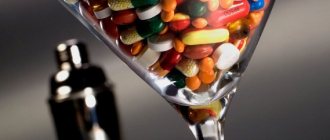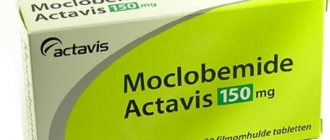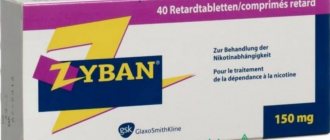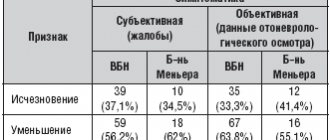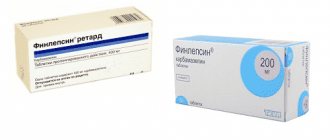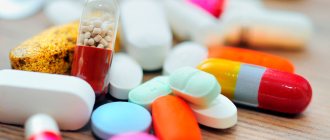Haloperidol is a drug that belongs to the group of antipsychotics. It is one of the first antipsychotic drugs. Today, a huge number of new medications are being developed, but their effectiveness in trials is always compared with the effect of haloperidol.
In medical practice, the medicine is actively used by psychiatrists in the treatment of various neurological diseases and mental disorders.
Release form and composition
Haloperidol is a typical antipsychotic. The active substance in the medicine is a butyrophenone derivative of the same name. The medicine is produced in various forms, which allows you to accurately select the required dosage.
The most popular products are for oral use: tablets and concentrate. A second form of the medication is also available as a nasal spray. Tablets can be purchased in different dosages - 1.5 mg or 5.0 mg.
Haloperidol is produced in the form of a short-acting solution, which is intended for intramuscular and intravenous administration. In addition, a long-acting medicine is offered, which is administered intramuscularly and maintains its effect for 3 weeks.
Correction of complications
Withdrawal syndrome is prevented by a slow reduction in the dose of Haloperidol. This action allows you to avoid increased resistance of CNS receptors and painlessly overcome the end of the course of treatment. If a problem is formed, the following actions are used:
- Replacing Haloperidol with a new antipsychotic drug not previously taken by the patient while simultaneously reducing the dose of the “old” drug.
- Prescription of auxiliary medications - antidepressants, tranquilizers and nootropics.
- In difficult clinical situations - purification of the blood from Haloperidol metabolites using infusion therapy and plasmapheresis.
- Symptomatic treatment is the prescription of beta blockers to correct complications of the heart and blood vessels (Atenolol, Anaprilin), anticholinergic drugs to eliminate extrapyramidal disorders (Atropine, Biperiden) and benzodiazepines to relieve neurological and mental disorders (Diazepam, Midosalam).
Impact
The therapeutic effect of haloperidol is associated with the substance’s ability to block dopamine receptors, as well as inhibit adrenaline and adrenergic receptors in the brain. This makes it possible to normalize human behavior in mental disorders. In addition, the drug has an antiemetic effect.
While taking the drug it is possible to:
- Reduce physical activity.
- Remove signs of aggression.
- Elimination of hallucinations and mania.
- Increase interest in the world around you.
The maximum concentration of the active substance is achieved:
- After oral use after 3-6 hours.
- After intramuscular injection of a short-acting drug, after 10-20 minutes,
- After intramuscular administration of a prolonged drug after 3-9 days.
Treatment
The drug haloperidol is an antipsychotic drug that has a pronounced antipsychotic effect. It causes inhibition of the reflexes of the central nervous system, due to which it is successfully used to treat delirium tremens, manic and delusional states, hallucinatory disorders, etc.
The drug is used during addiction treatment, it allows you to minimize the risk of developing psychosis, as well as relieve associated symptoms: vomiting, nausea, fever and others. Also, with its help, you can get rid of hallucinations and delusions in a short time.
When is haloperidol prescribed?
Haloperidol, the instructions for use indicate this, is often prescribed orally or intramuscularly for psychoses of various origins. It helps stabilize the condition of patients suffering from:
- Manic disorders, characterized by increased levels of agitation and an inability to control behavior.
- Oligophrenia, the symptom of which is mental retardation.
- Schizophrenia, the symptoms of which are fundamental disturbances in the perception of the surrounding world.
- Paranoia, the symptom of which is excessive suspicion.
Neuroleptic treatment haloperidol, the instructions focus on this, indicated for
Gilles de la Tourette syndrome. This genetic disorder is characterized by uncontrollable multiple vocal and motor tics.
The drug is indicated for the development of Huntington's chorea. This is a hereditary, constantly progressive disease, which is manifested by a gradual deterioration of speech, memory and involuntary unusual movements that complicate daily activities.
The drug is prescribed for various psychosomatic disorders and behavioral disorders in the elderly and children. The medicine is effective in the prevention and treatment of nausea and vomiting that occurs during chemotherapy.
Features and symptoms
To relieve such disorders, various medications are used: sedatives, psychotropics, antipsychotics.
One of the most common and terrible consequences is delirium. For its treatment, haloperidol is used in tablets or drops. The condition after abruptly quitting alcohol the day before is characterized by the following symptoms:
- disorientation in space and time;
- convulsive seizures, tremors of limbs;
- mood swings, especially in the evenings;
- panic attacks, anxiety, increased aggressiveness;
- the occurrence of hallucinations of various types;
- increased body temperature, tachycardia, arrhythmia, pale skin, increased blood pressure, etc.
This condition should be treated only in medical clinics under the supervision of experienced specialists. Otherwise, you can provoke serious consequences, even death.
Terms of use
The peculiarity of haloperidol treatment is that the medicine is always initially prescribed in minimal doses: 0.5-5 mg 2-3 times a day. The dosage for older people is reduced to 2 mg. Depending on the reaction of the patient’s body and the results obtained, the dose of the drug is gradually increased to 5-10 mg per day.
Other recommendations:
- When administered intramuscularly, the initial single dose is 1-10 mg, repeated injection is possible after 1-8 hours.
- When administered intravenously, the initial single dose is 0.5-50 mg, repeated injection is prescribed depending on the indications and condition of the patient.
- When using a long-acting dosage form, the medicine is administered at a dose of 50-300 mg once every 4 weeks.
During treatment with haloperidol, the patient's condition must be monitored. If a positive stable result is recorded, the drug is discontinued.
Application in drug treatment practice
In narcology, Haloperidol is used to relieve acute psychoses of various origins, including hallucinogenic, intoxicating, caused by amphetamines, cocaine and other psychostimulants. The drug is effective against alcoholic delirium and pharmacogenic psychoses in people suffering from opium addiction. Let's consider the basic principles of treatment with neuroleptics.
Substance abuse therapy
Treatment of alcoholism and drug addiction occurs in stages. Initially, the body is detoxified and symptomatic therapy is prescribed to relieve withdrawal syndrome - it includes thiamine (vitamin B1), benzodiazepine derivatives (tranquilizers), barbiturates (hypnotics) and carbamazepine (mood stabilizers, anticonvulsants). If at this stage there is severe psychomotor agitation or hallucinations, Haloperidol is added to the complex treatment regimen.
At the second stage, the stage of active therapy, it is necessary to suppress the patient’s mental dependence. In this case, Haloperidol is prescribed in small doses, often in combination with tranquilizers, to relieve borderline psychopathological conditions, including increased anxiety, excitability, etc.
At the third stage, rehabilitation measures are carried out. The decision to continue antipsychotic therapy with Haloperidol is made by a specialist, taking into account clinical indications. In most cases, the drug is slowly withdrawn at this stage.
Treatment of post-withdrawal syndrome
For atypical forms of central nervous system damage in persons with alcoholism, Haloperidol is considered as a first-line drug (along with other typical antipsychotics). We are talking about acute psychoses of the paranoid spectrum and hallucinosis. After relief of the withdrawal syndrome, such patients experience psychopathic, affective and asthenic disorders.
In drug treatment practice, haloperidol is used to relieve psychoses of various origins, including intoxication psychoses caused by the action of hallucinogens, cannabinoids, amphetamine-type psychostimulants and cocaine. Haloperidol is effective in the treatment of alcoholic delirium and alcoholic hallucinosis, as well as pharmacogenic psychoses in patients with opium addiction.”
On the fundamental possibilities of neuroleptic therapy in narcology
Haloperidol is able to selectively influence the listed complications, stopping them. If the antipsychotic is not effective, the drug can be replaced with the antidepressants Lerivon or Amitriptyline. In case of predominance of asthenic symptoms (bradycardia, arterial hypotension, impotence, etc.), additional intake of non-alcohol adaptogens (Eleutherococcus, Ginseng, etc.) is recommended.
Relapse Prevention
During treatment, psychotherapy and social rehabilitation of patients are carried out along with neuroleptic correction of mental and neurological disorders. In the latter case, preference is given to typical antipsychotics, in particular Haloperidol. The drug weakens secondary forms of painful craving for alcohol and illegal substances, facilitates the implementation of a rehabilitation program, acting as a so-called “behavior corrector.”
The use of Haloperidol and other typical antipsychotics in drug treatment practice is considered clinically justified. Correct use of the drug allows you to avoid side effects and complications characteristic of long-term or inadequate use of antipsychotics.
Contraindications and side effects
The main contraindication for the antipsychotic drug is hypersensitivity to haloperidol. It is strictly forbidden to treat children under 7 years of age. Since studies of the effect of the drug on the fetus and newborn child have not been carried out by women during pregnancy and breastfeeding, they should also not take the drug.
Other contraindications and restrictions for taking the drug are indicated in the instructions for use. You also need to carefully study all possible adverse reactions of the body. If any negative manifestations occur, treatment with this antipsychotic should be discontinued.
Overdose is very dangerous. It can provoke severe extrapyramidal disorders, manifested by movement disorders. Also, with an overdose, the risks of developing arterial hypotension increase. Other characteristic symptoms are drowsiness and lethargy. In severe cases, coma, respiratory depression, and shock occur. There is no antidote to eliminate the symptoms of an overdose, so measures are taken that are aimed at eliminating the symptoms.
Haloperidol drops, solution and tablets can be purchased at an affordable price, but only with a prescription. Numerous reviews confirm the effectiveness of treatment with the drug when indicated. The risks of side effects increase if medical recommendations are violated.
What happens in the body during an overdose of psychotropic substances?
Ethanol and psychotropic substances in combination with Haloperidol can cause serious side effects that addicts mistake for drug intoxication.
Such complications include a feeling of euphoria, psychomotor agitation, involuntary muscle activity, hallucinations, increased libido, prolonged erection, and autonomic disorders. In case of an overdose of butyrophenone, Haloperidol itself can cause the listed side effects. Any psychotropic drug consists of chemical components that can cause the following reactions in the body:
- delay of physiological processes in the body
- inhibition of various reflexes and responses
- CNS inhibition
- suppression of a person’s brain centers and nervous activity, against the background of which he becomes indifferent to the realities happening around him
The formation of indifference and artificial mood against the background of changes in muscle tone can be provoked by incompletely studied processes in the body at the level of higher nervous activity. Moreover, all side effects are explained by the result of chemical processes in the body.
Unfortunately, a true overdose of Haloperidol is not limited to just the reactions listed. Intoxication of the body affects not only a person’s consciousness, but also creates a real threat to his life. Following euphoria, a person may experience respiratory depression, a sharp decrease in blood pressure, and progressive cerebral edema leading to coma. If the antipsychotic was supplemented with ethyl alcohol or other psychotropic substances, the listed symptoms increase rapidly.
Help for drug addicts
A person who has become dependent on haloperidol needs rehabilitation - a return to the original good state. He had a reason to take the medicine—a problem he couldn't handle, physical pain, or emotional distress about something. Having taken the pill, he dealt with this problem, and began to choose this method more and more often to solve this problem, and then to solve other problems.
Using the program, a person will be able to find these causes and eliminate them. He will also cope with the consequences of abuse and recover mentally, regain his mental comfort - the one that will keep him away from the dose. Thanks to the program, he will get out of the trap and regain his full life.
Do not abuse drugs! And if this has already happened, then call us right now!
Share:
Sibutramine
Alpha PVP
Other medicines
The use of doxepin recommended by some authors when withdrawing from binge drinking is considered unacceptable due to the high risk of complications - arterial hypotension, arrhythmias and toxic delirium. The administration of phenothiazine neuroleptics (aminazine and tizercin) practiced by some doctors when withdrawing from binge drinking should be considered unacceptable, because These drugs increase the likelihood of developing delirium, seizures and have a proarrhythmic effect. It is known that after the introduction of phenothiazine antipsychotics into practice for the treatment of delirium in the 50s. mortality from it increased 4 times. The co-administration of barbiturates and tranquilizers should be avoided when withdrawing from binge drinking due to excessive sedation and the combination of β-blockers and clonidine due to the risk of developing arrhythmias. A fairly common mistake when withdrawing from binge drinking is forced diuresis. From a pathophysiological point of view, this is not justified in any way, because The cause of withdrawal syndrome is the reaction of neurotransmitter systems to a drop in the concentration of alcohol in the blood, and not ethanol metabolites circulating in the blood. Accelerated elimination of alcohol during withdrawal from binge drinking at home leads to an increased risk of developing seizures and delirium. Infusion therapy with polyionic solutions is indicated for patients with severe dehydration or persistent vomiting. In most cases, oral rehydration is sufficient for recovery from binge drinking.
Contraindications for use
Currently, intravenous administration of haloperidol is prohibited by US law. The process requires careful preparation and precise actions on the part of medical personnel. The drug must be administered very slowly to avoid severe reactions in the body. There are absolute and relative contraindications to the use of this drug, including:
- coma
- intoxication of the body
- allergic reactions
- age up to 3 years
- pregnancy and lactation
- Parkinson's disease
- epilepsy
- depressed emotional state
- heart diseases
- liver disease
- angle-closure glaucoma
- endocrine disorders
- BPH
- therapy with blood thinners
- VSD
It is strictly forbidden to combine haloperidol and alcoholic beverages. This may lead to unpredictable negative consequences. As for the dosage, exceeding it can lead to severe side effects; for this reason, the use of this medication is possible only under the supervision of a doctor.
